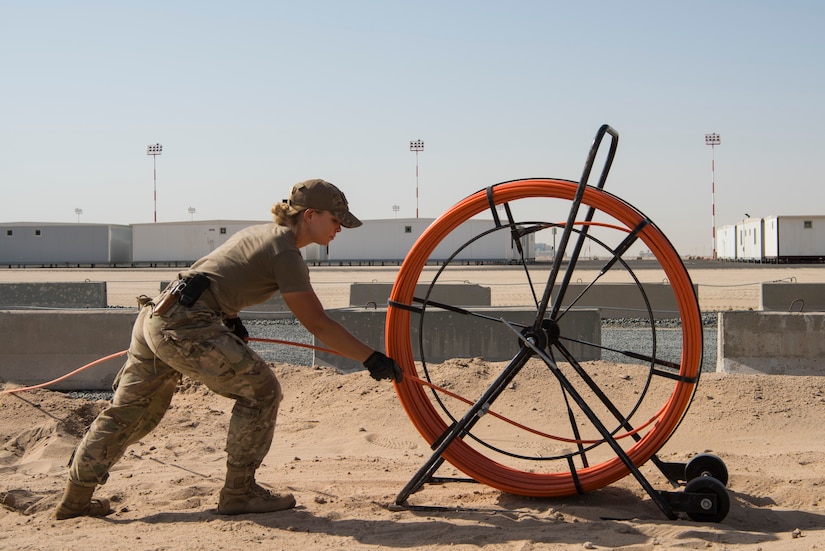By Air Force Staff Sgt. Christopher Stoltz, 386th Air
Expeditionary Wing
ABDULLAH AL-MUBARAK AIR BASE, Kuwait -- Construction is
nearly complete on “Cargo City,” a new operating location for U.S. and
coalition forces to conduct aerial port operations in Kuwait.
The aerial port will continue to serve as a major military
logistics point and also functions as the largest aerial port of debarkation in
the Middle East.
Cargo City, located next to a vacant aircraft parking ramp
at Kuwait International Airport, will serve as home to Kuwaiti air force, U.S.
military and coalition personnel during the airport’s massive expansion. The location
will serve as a temporary operating location until its replacement, West
Al-Mubarak Air Base, is complete, which is projected to be in 2023.
“Once finished, the total functional space at Cargo City
will feature an area of nearly 33,000 square meters,” said Air Force Capt. Sean
Murphy, the 387th Expeditionary Support Squadron’s civil engineering flight
officer in charge. “We are optimizing our workspace by reducing our footprint
from 230,000 square meters, excluding the flight line.”
Murphy said the consolidation of joint-service units and
personnel will provide a higher ceiling of capability, as it enables direct
contact with coalition and host-nation partners, streamlining communications
processes by proximity alone. While the project will benefit all parties
involved, he said, it did not come without its initial set of challenges.
“Moving everything to an entirely new location does not seem
ideal at first, and building an entire base from scratch is a different
conversation altogether,” he said. “The current base personnel also have to
overcome the displacement of staff -- all while still executing their mission.”
Forming Friendships, Building Bonds
The move wasn’t all bad news for Murphy and the 386th
Expeditionary Civil Engineer Squadron team, however. Their victories included
more than just turning a blank slate into to a fully functional operating
location.
“During the build process, we were able to form friendships
and build bonds with our generous host-nation partners,” he said. “We wanted to
go into this project with the clear intentions of building not just an
operating location, but a lasting partnership.”
This partnership was evident during the build and
construction process, as the 386th ECES and 387th ESPTS relied on their Kuwaiti
counterparts for a colossal project: importing more than 1.24 million cubic
meters of fill for the construction site.
“When we first arrived, the build site was not even close to
ideal for our goals,” said Air Force Capt. Jesse Lantz, 386 ECES deputy
commander. “The entire site was pretty much a 10-foot deep hole and needed to
be filled in and graded properly, which is a huge project in itself. After a
few meetings, we were able to hammer out a logistics plan for the site and get
to work alongside the Kuwaitis.”
Construction
And get to work they did. To make the land suitable for
construction, a team of local trucking companies performed 24-hour operations,
transporting nearly 400 trucks of soil, dirt and rock every day. This operation
lasted nearly four months.
After the task to fill, level, and compact the construction
site was complete, the squadron began building the war-reserve material
shelters, which are slated to serve as the new operating location for the 5th
Expeditionary Air Mobility Squadron’s aircraft maintenance mission.
In addition to building the base’s facilities, the 386 ECES,
the 387 ESPTS, 1st Expeditionary Civil Engineer Group, and the Army’s 505th
Engineer Battalion teamed up to install the heart and soul of the base:
electricity and communications lines.
“After the site was prepared, we had three months to have
the base move-in ready,” said Lantz, who has an extensive background in
construction and project management. “Just a short time ago, there was nothing
here but a patch of land. It is amazing to see something of this scale develop
in front of your eyes.”
Lantz said while he may not be able to see the result of
this $32 million project in person, he plans on contacting his replacement to
request photos. With the Kuwait-contracted effort to complete the aircraft
parking ramp slated to be complete in August and the connecting taxiway slated
for a November completion, there will be plenty of photos for his successor to
send.
While Cargo City will be replaced eventually, Lantz said,
the project will ease the transition to the final destination, West Al-Mubarak
Air Base, once it is complete.
“Cargo City was built with the intention of being a
temporary solution, but will have long-lasting benefits,” he said. “This is one
of the projects I am most proud of in my career. The teams here did an
incredible job, and I look forward to what this location will be capable of in
the very near future."

No comments:
Post a Comment